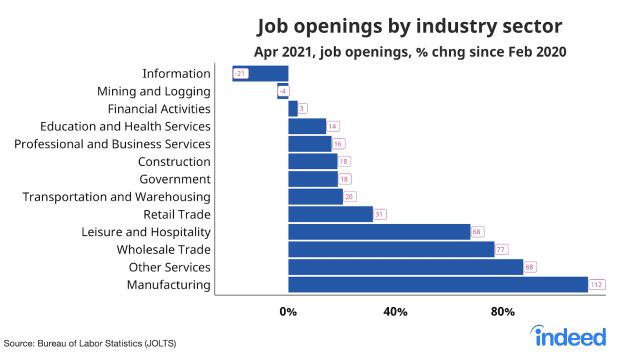This post was originally published on this site
When the economy shut down last year to curb the spread of coronavirus the leisure and hospitality industry, which includes hotels, restaurants and bars, took a gut-wrenching hit.
Some 8.2 million people who worked in the sector were laid off or furloughed between February and April 2020, according to data from the Bureau of Labor Statistics.
Now that most pandemic restrictions have been lifted, Americans are back to dining out and booking vacations — and business owners are looking to fill nearly 1.6 million openings, a 68% increase in openings compared to February 2020.
Contrast that narrative with the manufacturing industry.
Some 1.4 million people were laid off or furloughed from February to April 2020. But as of last month business owners are hiring for 851,000 positions — a record high for the industry and a 112% increase in openings since last February.

Manufacturing firms “are desperate for workers and they would take anybody in off the street and help them learn what they need to know to start,” Carolyn Lee, who is in charge of workforce development for the National Association of Manufacturers, a trade association, told MarketWatch.
The record rate of openings in the industry comes as 1.7 million workers over 55 unexpectedly retired during the pandemic, according to a recent report published by the Schwartz Center for Economic Policy Analysis, part of New York’s The New School.
“
Over the past two months, 837,000 manufacturing jobs were added. Meanwhile, 9.3 million positions were left unfilled.
”
Health concerns likely played a big role in pushing older Americans to retire during the pandemic, the report said.
The trend has been particularly troublesome for the manufacturing industry where the median age for workers was 44.4 in 2020, two years higher than the overall median age across all occupations, according to data from the U.S. Census Bureau.
“We definitely have an older workforce,” Lee said. “People are leaving the top end of the funnel, and people [are] not coming in and behind to replace them.”
The biggest hurdle the industry faces is attracting younger workers who either aren’t aware of job openings in the industry or have no interest in joining the sector — a product of a “perception gap,” Lee said.
“People don’t know that these are jobs that are available and that these are jobs or that these are jobs they’d want.”
Men hold some 71% of all manufacturing jobs
What’s more, women made up just 29% of all manufacturing jobs in May 2021 even though they comprise nearly 50% of the workforce, according to BLS data.
That’s hardly a coincidence considering “we as a society foster from kindergarten: ‘OK girls, you play with the pink doll set and boys, you can have the hardhat and the digger,’” Nicole Smith, chief economist at Georgetown’s Center on Education and the Workforce, previously told MarketWatch.
“
We as a society foster from kindergarten: ‘OK girls you play with the pink doll set and boys, you can have the hardhat and the digger’
”
That’s perpetuated stereotypes that “play themselves out in women’s perceptions of what they’re suited for and what they ought to be doing,” Smith said.
It’s also helped contribute to a significant “PR problem” in infrastructure and manufacturing where women are convinced that every job requires heavy lifting and a hardhat, she added.
Some workers are waiting until enhanced unemployment benefits expire
But retirement and PR problems aside, some manufacturing firms complain that labor shortages, which employers across the board are confronting, are the reason why there’s a record number of job openings.
Over the past two months some 837,000 manufacturing jobs were added — far below the 1.6 million jobs economists were forecasting for April and May. Meanwhile, there were 9.3 million unfilled positions in the U.S. in April, according to the Department of Labor’s Job Openings and Labor Turnover Survey.
That’s equivalent to the number of people who are currently unemployed, according to the latest jobs report.
At least 25 Republican governors believe that the extra $300 a week in unemployment benefits is overly generous and is contributing to mounting complaints they hear from employers who cannot fill job vacancies.
As a result, they’re prematurely cutting some 4 million jobless recipients off from enhanced benefits in the coming weeks — months before they expire in early September.
Anecdotally, Lee said she has heard that some applicants are telling manufacturing employers that they’re waiting until enhanced unemployment benefits end in their state before they take on a new role.
But there’s “no definitive proof” across the industry or data to prove that it’s the case, Lee told MarketWatch.



